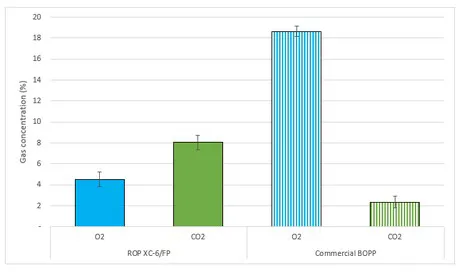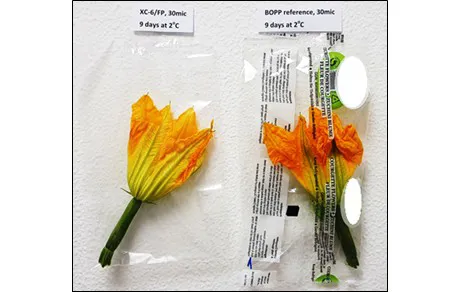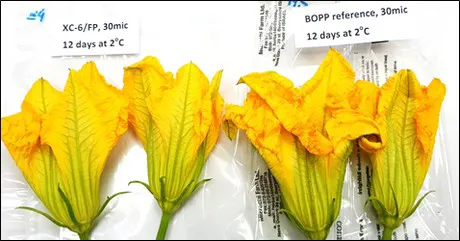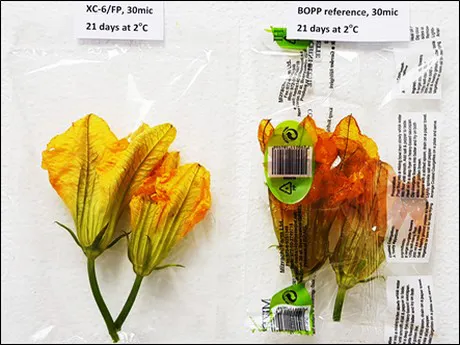While the demand for edible flowers is on the increase, the challenge for its expansion remains with the limited post-harvest shelf life of this delicate product. Once harvested the perishable flower tissue starts to dehydrate compromising its appearance. Research also pointed out that its nutritional value, the antioxidant content rapidly decreases.
The varieties of edible flowers continuously expand, however among the most popular are the zucchini (Cucurbita pepo) blossoms, male or female. The bright yellow color, soft and delicate texture, slightly sweet flavor of zucchini flowers has made them a favorite ingredient in the U.S.A., Europe and Asia. The male flower is usually smaller in its overall size and it has a short stem and the female flower often has a young zucchini (baby zucchini) attached to it. These flowers can be eaten raw as a garnish or chopped and added to salads. Gourmet restaurants also serve it stuffed with herbs and cheeses, fried or baked until the delicate petals become crispy.
Researchers set the foundation for longer shelf-life and nutrition values retention
Several research studies conducted in recent years evaluated the effect of storage under controlled atmosphere (CA) on physicochemical parameters and antioxidant compounds contents of these flowers. Flowers were stored at 5° C under various Oxygen-Carbon dioxide-nitrogen combinations. Compared with the control (20% O2, 0% CO2 and 80% N2), the CA treatments showed better retention of various parameters related to freshness and delayed senescence. Stored under low O2 and high CO2 concentrations, thus reducing respiration rate, decreasing enzymatic activity and diminishing the changes associated with senescence, higher total sugars and soluble solids, less weight loss and higher amount of ascorbic acid, polyphenols and carotenoids were documented. The exposure to the beneficial gas combination was demonstrated to prolong postharvest life in squash flowers up to 16 days.
Turning theory into practice
Using these research findings and to the request of a renown edible flowers grower, Dr. Wentao Jia, ROP's polymer engineer together with her colleague, postharvest specialist Shay Zeltzer, initiated a set of lab and field trials aimed at engineering the film most suitable for developing those conditions which were reported to protect the freshness of flowers. Packaging that reduces respiration-rate and plant metabolism.
"We were requested to develop a packaging for packing of single female flower or two male flowers per packaging," says Dr. Jia. "The annual capacity expected to be packed dictated that the film developed should work on a horizontal flow-pack machine. With sustainability in mind, we were looking to engineer the lowest-gauge film possible that could still run smoothly and efficiently on the flow-pack machine. The small bio-mass packed presented a challenge of its own, adds Zeltzer. The existing films used by the industry are BOPP based that are laser perforated. We've learned that these could not allow for the building of the required beneficial gas composition inside the bag. It was clear that we'll have to stay away from the various perforation options as the natural respiration of such a small bio-mass will not be able to alter the atmosphere inside the bag."
The following chart presents the atmosphere created inside the bags made of the film developed by ROP (solid bars) vs. the commercial, laser-perforated, BOPP film (stripped bars). While the O2/CO2 composition inside the commercial bag was very close to the atmospheric conditions, the bag developed by ROP was shown to allow for reducing the O2 and increasing the CO2 to the values recommended by the academic research.

Freshness and quality parameters preserved
As expected the reduced respiration rate resulted in delayed manifestation of senescence-related phenomena. With the female flowers, within seven to nine days from packing, the flowers packed in the micro-perforated BOPP film became darker in color, indicative of an aging tissue; it developed water-soaked areas appeared as darker translucent patches on the petals, starting from the edges. Also, the overall presentation of the petals of these flowers looked wilted.

Fig. 1: Female zucchini flower 9 days after packing in ROP MA bag (left) and commercial BOPP micro-perforated bag (right). The flower on the right becomes darker and wilted indicative of an aging tissue. Senescence related phenomena are retarded in the flower on the left (ROP bag).
Male flower tested had an overall longer shelf life than the female flower. Differences in the development of the senescence-related phenomenon noted about 12 days after packing.

Fig. 2: Male zucchini flower 12 days after packing in ROP MA bag (left) and commercial BOPP micro-perforated bag (right). Wilting and darken color at the edges of the petals for the flower is indicative of advanced aging compare to the flower in ROP bag that is lighter in color showing no wilting.
The flowers were further kept in cold storage at 2° C for another 10 days when the differences between the conditions of the flowers in the two packagings tested were not questionable.

Fig. 3: Male zucchini flower 21 days after packing in ROP MA bag (left) and commercial BOPP micro-perforated bag (right). Complete disintegration of the flower tissue is observed with the flower packed in the commercial BOPP bag, while the flower in ROP bag is starting to show some aging indications at the edges of the petals.
Going commercial and next step
ROP's film for male and female zucchini flowers is already in commercial use since two months ago. Thousands of bags being shipped by cross Atlantic air-freight strengthens the confidence with the advantages of the packaging developed. "We're looking forward to expanding our line of products for the edible flowers category including rose petals, viola tri-color and nasturtium", concludes Zeltzer.
For more information:
Shay Zeltzer
Tel: +972-52-2708903
Email: shay@rop-ltd.com
www.rop-ltd.com
